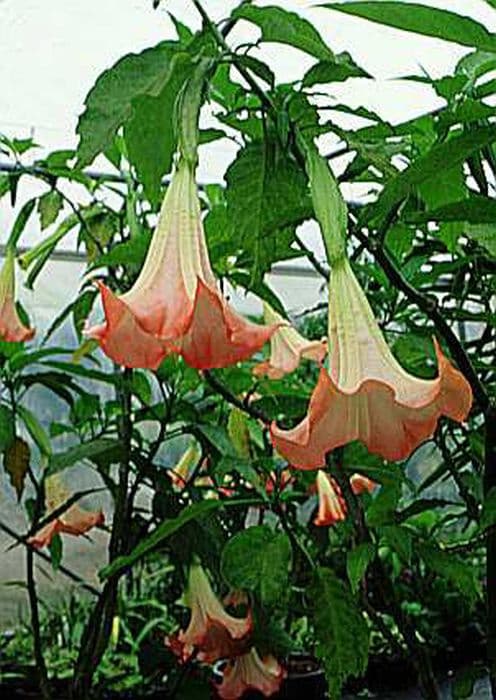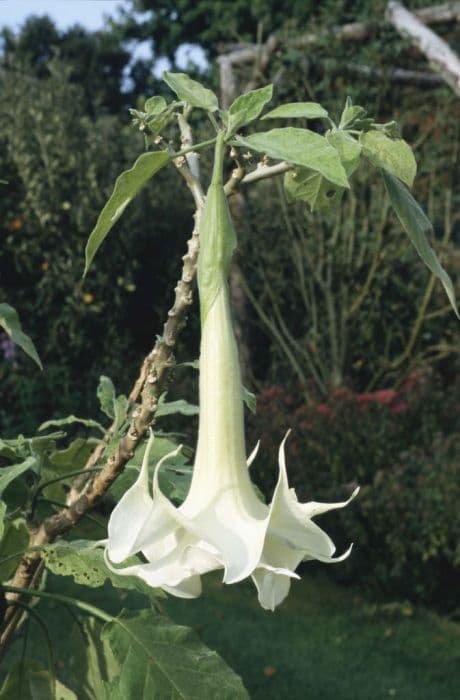Million Bells Calibrachoa Can-can Apricot = 'Balcanapt' (Can-can Series)
![calibrachoa [Can-can Apricot]](/_next/image?url=https%3A%2F%2Fplants-admin.emdemapps.com%2Fimages%2Fplants%2F%2Fimages%2F604b553eb8056.png&w=3840&q=75)
ABOUT
The Calibrachoa Can-can Apricot, belonging to the Can-can series, is a charming, prolific flowering plant known for its cascades of apricot-hued blossoms. These flowers bear a close resemblance to miniature petunias, with a funnel-like shape that is both delicate and alluring. The apricot coloring is a warm tone that blends hues of pink and orange, offering a soft yet vibrant visual appeal. The throat of each bloom often displays a slightly darker shade, which provides a subtle contrast and adds depth to the overall floral display. These blooms are tightly clustered, creating a full and lush appearance. Foliage on the Calibrachoa Can-can Apricot is of a bright green, contributing to the plant's cheerful and refreshing look. The leaves are small and narrow with a somewhat lance-like shape, serving as a fine backdrop to the showy flowers. The growth habit of this variety is such that it creates a mound or a gently spilling effect, making it a favored choice for container gardening, hanging baskets, and even as a seasonal ground cover. With its profuse blooming and vivacious colors, this plant adds a touch of perennial summer to any setting, consistently enchanting onlookers with its petite yet abundant flowers.
About this plant
 Names
NamesFamily
Solanaceae
Synonyms
Million Bells, Trailing Petunia, Mini Petunia
Common names
Calibrachoa Can-can Apricot = 'Balcanapt' (Can-can Series).
 Toxicity
ToxicityTo humans
Calibrachoa, commonly known as million bells, is not known to be toxic to humans. However, as with any non-edible plant, it is not recommended to ingest any part of it. If large quantities are accidentally consumed, it may cause mild gastrointestinal discomfort or an allergic reaction in some individuals. It is always best to keep ornamental plants out of the reach of children who might accidentally ingest them.
To pets
Calibrachoa, also known as million bells, is not listed as toxic to pets. While it is generally considered safe, pets should not consume plants that are not intended for consumption. If a pet ingests a significant amount of the plant, they may experience mild gastrointestinal upset, including vomiting or diarrhea. It is advisable to monitor your pet and consult a veterinarian if any signs of distress occur after ingestion.
 Characteristics
CharacteristicsLife cycle
Annuals
Foliage type
Evergreen
Color of leaves
Green
Flower color
Apricot
Height
0.66 feet (20 cm)
Spread
1.64 feet (50 cm)
Plant type
Herb
Hardiness zones
9
Native area
South America
Benefits
 General Benefits
General Benefits- Vibrant Color: Adds a pop of warm apricot color to gardens, containers, and hanging baskets.
- Long Blooming: Flowers continuously from spring through fall, providing extended visual interest.
- Easy to Grow: Known for being low-maintenance, requiring minimal care to thrive.
- Heat Tolerant: Performs well in warm climates and during hot summer months.
- Drought Resistant: Once established, it can tolerate periods of dryness, reducing the need for frequent watering.
- Compact Growth: Suitable for small spaces due to its mounding and trailing growth habit.
- Attracts Pollinators: Flowers are attractive to hummingbirds, butterflies, and other beneficial insects.
 Medical Properties
Medical PropertiesThis plant is not used for medical purposes.
 Air-purifying Qualities
Air-purifying QualitiesThis plant is not specifically known for air purifying qualities.
 Other Uses
Other Uses- As a natural dye: The petals of Calibrachoa may be boiled to extract natural pigments for use in eco-friendly textile dyeing.
- In crafting: Dried flowers of Calibrachoa can be incorporated into homemade paper to create a unique texture and design.
- In educational projects: Cultivating Calibrachoa can be used as a hands-on teaching tool for children to learn about plant growth and botany.
- As a photography subject: Due to its vibrant colors, Calibrachoa is an excellent subject for macro photography enthusiasts looking to capture the beauty of flowers.
- In container water gardens: Calibrachoa can be floated in a small water-filled container as a temporary decorative element for garden parties.
- As a natural confetti: Dried petals of Calibrachoa can be used as biodegradable confetti for outdoor celebrations.
- In potpourri: Use dried Calibrachoa flowers to add color and a mild fragrance to homemade potpourri mixes.
- For miniature gardens: Due to their small size, Calibrachoa plants are a good addition to fairy gardens or other types of miniature gardens.
- In hanging ornaments: Small bouquets of Calibrachoa can be dried and used to create decorative hanging ornaments for patios or windows.
- As scented bookmarks: Lightly scented with essential oils, Calibrachoa's dried petals could be crafted into bookmarks that release a gentle fragrance while reading.
Interesting Facts
 Feng Shui
Feng ShuiThe Million Bells is not used in Feng Shui practice.
 Zodiac Sign Compitability
Zodiac Sign CompitabilityThe Million Bells is not used in astrology practice.
 Plant Symbolism
Plant Symbolism- Endurance: Calibrachoa, also known as Million Bells, are resilient plants that can tolerate varying weather conditions, symbolizing the ability to endure and persist through challenges.
- Abundance: The prolific blooming nature of Million Bells, with their numerous small flowers, signifies abundance and prosperity.
- Grace: With delicate, bell-shaped flowers, Million Bells can represent grace and gentleness in one's life.
- New Beginnings: The continual blooming cycle of Million Bells can symbolize fresh starts and new opportunities.
- Charm: The small, petunia-like blooms of Million Bells have a sweet charm to them, often representing attractiveness and the power to delight.
 Water
WaterMillion Bells, commonly known as Calibrachoa, thrive when watered thoroughly once the top inch of soil feels dry. In hotter weather, this may mean watering as often as every day, but in cooler or cloudy conditions, watering may be reduced to every 2 to 3 days. Aim to provide enough water so that it evenly wets the soil without standing water; this could be approximately 1 gallon per week depending on the environment and pot size. The goal is to maintain a consistent moisture level without overwatering, which can lead to root rot.
 Light
LightMillion Bells prefer full sun to partial shade conditions. Providing them with at least 6 to 8 hours of direct sunlight daily is ideal for robust growth and flowering. An east or west-facing spot that receives morning or late afternoon sun is suitable, ensuring they are protected from the harshest midday sun which can sometimes be too intense, especially in warmer climates.
 Temperature
TemperatureMillion Bells perform best in temperatures between 55 and 65 degrees Fahrenheit at night and 65 to 85 degrees Fahrenheit during the day. They can tolerate temperatures as low as 50 degrees Fahrenheit without risk of frost damage, and typically do not thrive in conditions above 90 degrees Fahrenheit. To encourage continuous blooming, keep them within their ideal temperature range.
 Pruning
PruningPruning Million Bells encourages healthy growth and prevents the plants from becoming leggy. Regularly pinch back the stem tips every few weeks to promote bushier growth and more flowers. The best time to prune is in late winter or early spring before the new growth starts, and continue pinching back as needed throughout the growing season to maintain shape and vigor.
 Cleaning
CleaningAs needed
 Soil
SoilMillion Bells prefer well-draining and fertile soil with a pH range of 5.5 to 6.0. A good mix would be equal parts peat moss, potting soil, and perlite or sand to ensure proper drainage and aeration.
 Repotting
RepottingMillion Bells should be repotted annually to refresh the soil and to accommodate root growth, typically in the spring before the onset of the growing season.
 Humidity & Misting
Humidity & MistingMillion Bells thrive at average to high humidity levels but are tolerant of various conditions as they are adaptable plants; just avoid extremely dry air.
 Suitable locations
Suitable locationsIndoor
Use bright, indirect light and well-draining soil mix.
Outdoor
Plant in full to partial sun in a well-draining spot.
Hardiness zone
9-11 USDA
 Life cycle
Life cycleThe Calibrachoa 'Can-can Apricot', commonly known as Million Bells, begins its life cycle from seed or vegetative cuttings, with germination occurring typically within a warm and moist environment. Once sprouted, the seedling goes through a vegetative stage, developing roots, stems, and leaves, and matures into a fully-grown plant. As it enters the flowering stage, the plant produces abundant trumpet-shaped apricot flowers, attracting pollinators and potentially self-sowing if conditions allow. Following pollination, if it occurs, the flowers develop into small, non-prominent seed pods that carry seeds for the next generation. In climates where it is not perennial, the plant will reach the end of its life cycle with the onset of frost, as it is not frost-tolerant. In warmer regions, or when grown as a perennial in controlled conditions, it can continue to live and flower over multiple years, repeating the flowering and, if conditions permit, the seeding stages annually.
 Propogation
PropogationPropogation time
Spring to Summer
The most popular method of propagating the Calibrachoa, commonly known as Million Bells, is through tip cuttings. The ideal time to take cuttings for propagation is late spring or early summer when the plant is actively growing. To propagate, one would snip a 4 to 6-inch (around 10 to 15 centimeters) section of stem from a healthy parent plant just below a leaf node, where the concentration of growth hormones is high. The lower leaves are then removed, and the cut end of the stem is dipped in a rooting hormone to encourage root development. Following this, the cutting is planted in a well-draining soil mix and kept moist until roots establish. This can take several weeks, after which the new plant can be gradually acclimated to less protected conditions and eventually planted out.


![Calibrachoa [Aloha Classic Blue Sky]](/_next/image?url=https%3A%2F%2Fplants-admin.emdemapps.com%2Fimages%2Fplants%2F%2Fimages%2F604b636c3778b.png&w=640&q=75)
![Calibrachoa [Aloha Classic Gold]](/_next/image?url=https%3A%2F%2Fplants-admin.emdemapps.com%2Fimages%2Fplants%2F%2Fimages%2F604b6284c573e.png&w=640&q=75)
![Calibrachoa [Aloha Classic Tiki Soft Pink]](/_next/image?url=https%3A%2F%2Fplants-admin.emdemapps.com%2Fimages%2Fplants%2F%2Fimages%2F604b548e0a5ef.png&w=640&q=75)
![Calibrachoa [Cabaret Deep Yellow]](/_next/image?url=https%3A%2F%2Fplants-admin.emdemapps.com%2Fimages%2Fplants%2F%2Fimages%2F604b5f20ca3ef.png&w=640&q=75)
![Calibrachoa [Calibasket Radiant Orange]](/_next/image?url=https%3A%2F%2Fplants-admin.emdemapps.com%2Fimages%2Fplants%2F%2Fimages%2F604b536d43cb2.png&w=640&q=75)
![Calibrachoa [Caloha Classic Blue Velvet]](/_next/image?url=https%3A%2F%2Fplants-admin.emdemapps.com%2Fimages%2Fplants%2F%2Fimages%2F604b604884a75.png&w=640&q=75)
![Calibrachoa [Caloha Classic Honey White]](/_next/image?url=https%3A%2F%2Fplants-admin.emdemapps.com%2Fimages%2Fplants%2F%2Fimages%2F604b5f56e0beb.png&w=640&q=75)
![Calibrachoa [Caloha Classic Yellow Chocolate Ring]](/_next/image?url=https%3A%2F%2Fplants-admin.emdemapps.com%2Fimages%2Fplants%2F%2Fimages%2F604b538aede95.png&w=640&q=75)